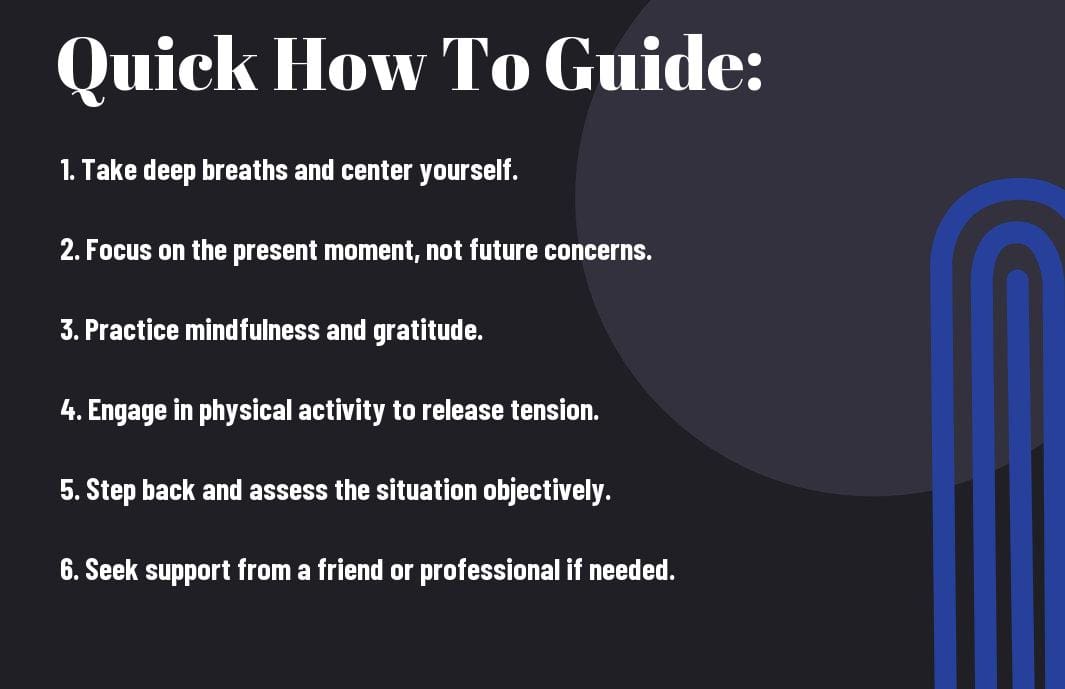You find yourself in the midst of chaos, feeling overwhelmed and stressed. But in these moments, it’s crucial to remember that staying calm is key to navigating through the storm. Learning how to find peace amidst chaos is a powerful skill that can transform how you handle stressful situations. In this guide, we will explore effective strategies and techniques to help you stay calm when everything around you feels chaotic. By implementing these practices, you can maintain a sense of inner peace and stability no matter what challenges come your way.
Key Takeaways:
- Practice mindfulness: By staying present in the moment, you can avoid getting caught up in the chaos and maintain a sense of calm.
- Utilize deep breathing techniques: Deep breathing can help regulate your body’s stress response and bring a sense of peace during turbulent times.
- Focus on what you can control: Instead of getting overwhelmed by things beyond your control, focus on the aspects of the situation that you can influence or change.


Recognizing the Factors That Contribute to Stress
Assuming control over our stress levels begins with understanding the factors that contribute to our feelings of overwhelm. By identifying these triggers, we can take proactive steps to manage and alleviate the stressors in our lives.
- Work pressure
- Financial struggles
- Relationship conflicts
- Health issues
- Major life changes
There’s power in acknowledging the specific triggers that affect us individually, as this self-awareness can help us develop personalized strategies for coping with stress. Understanding these triggers is the first step towards finding peace in chaos.
Identifying Personal Stress Triggers
There’s a deep connection between our thoughts, emotions, and responses to stress. By identifying your personal stress triggers, such as deadlines, social situations, or uncertainty, you can better anticipate and manage your reactions to challenging circumstances. Learning to recognize these triggers empowers you to navigate stressful situations with greater ease and resilience.
The Role of Environment and Relationships
Stress is not only internal but can also be influenced by external factors such as our environment and relationships. Our surroundings, including noise levels, organization, and lighting, can impact our stress levels significantly. Additionally, the quality of our relationships, both personal and professional, can either contribute to or alleviate stress. Plus, developing a supportive network and creating a conducive environment can help mitigate the impact of external stressors on our well-being.
How-To: Immediate Calming Techniques
Breathing Exercises for Instant Relief
An effective way to immediately calm yourself in stressful situations is through simple breathing exercises. By focusing on your breath, you can bring your attention to the present moment and slow down racing thoughts. One technique involves taking deep breaths in for a count of four, holding for four, and then exhaling for four. Repeat this process several times until you feel your body and mind start to relax.
The Power of Mindfulness and Presence
Clearly, practicing mindfulness and being fully present in the moment can help alleviate stress and bring a sense of calm. By paying attention to your surroundings, sensations, and thoughts without judgment, you can cultivate a greater sense of awareness and peace. Mindfulness allows you to acknowledge your feelings and thoughts without becoming overwhelmed by them.
Instantly bring your focus back to the present moment by engaging your senses. Notice the sights, sounds, smells, and textures around you. This grounding technique can help shift your attention away from stress and anxiety, promoting a state of relaxation.
Strategic Tips for Long-Term Stress Management
Now, when it comes to managing stress in the long term, it’s imperative to adopt strategic techniques that can help you stay calm and composed even in the face of chaos. By incorporating these practices into your daily routine, you can build a solid foundation for resilience and mental well-being.
Lifestyle Changes to Reduce Stress
The key to reducing stress lies in making positive lifestyle changes. This includes incorporating healthy habits such as regular exercise, adequate sleep, and a balanced diet into your daily routine. By taking care of your physical health, you can better equip yourself to handle the challenges that come your way.
Building a Resilient Mindset
Now, cultivating a resilient mindset is crucial for long-term stress management. This involves practicing mindfulness, self-care, and positive thinking. By shifting your perspective and focusing on growth rather than setbacks, you can develop the mental strength needed to navigate through stressful situations with confidence.
Plus, building a resilient mindset not only helps you cope with stress better but also empowers you to bounce back from setbacks and challenges stronger than before. By cultivating self-awareness and emotional intelligence, you can develop a positive outlook that will serve as a powerful tool in your stress management toolkit.
Creating Your Personal Peace Plan
When life gets chaotic and stressful, having a personal peace plan can help you navigate through the turmoil with grace and calm. By creating a customized strategy tailored to your needs, you can cultivate a sense of inner peace and stability even in the midst of chaos.
Tailoring Techniques to Your Needs
For effective stress management, it’s crucial to tailor relaxation techniques to suit your unique preferences and lifestyle. If you’re a visual person, try visualization techniques or creating a vision board. If you prefer physical activity, consider yoga or going for a run to clear your mind. Experiment with different techniques to find what works best for you.
Implementing and Adjusting Your Plan Over Time
Some stress management techniques may work better for you than others, and that’s okay. It is important to continually assess and adjust your peace plan to ensure its effectiveness. It is also crucial to be patient with yourself as you navigate through stressful situations, allowing for trial and error in finding the perfect combination of techniques that bring you peace.
To wrap up
Hence, finding peace in chaos and staying calm in stressful situations is a skill that can be developed through mindfulness, self-awareness, and practice. By taking control of our thoughts, emotions, and reactions, we can navigate through challenging times with composure and grace. Remember to prioritize self-care, set boundaries, and seek support when needed. By implementing these strategies, you can cultivate a sense of inner peace and resilience that will help you weather any storm that comes your way.
FAQ
Q: Why is it important to find peace in chaos?
A: Finding peace in chaos is crucial for maintaining mental and emotional well-being. It allows us to stay calm and focused in stressful situations, enabling us to make better decisions and handle challenges more effectively.
Q: What are some practical ways to stay calm in stressful situations?
A: Some practical techniques to stay calm in stressful situations include deep breathing exercises, mindfulness meditation, physical exercise, taking short breaks to relax, and positive self-talk. These methods can help reduce anxiety and promote a sense of inner peace.
Q: How can one cultivate a habit of staying calm in chaos?
A: Cultivating a habit of staying calm in chaos involves consistent practice and self-awareness. It’s important to prioritize self-care, set boundaries, manage time effectively, and seek support when needed. By incorporating these habits into your daily routine, you can train your mind to respond to stressful situations with composure and resilience.




